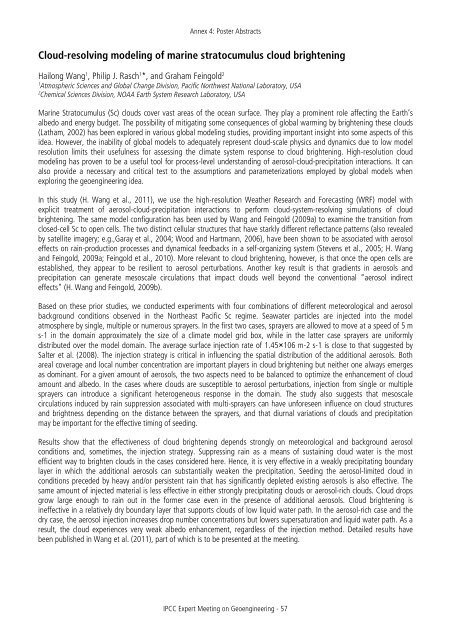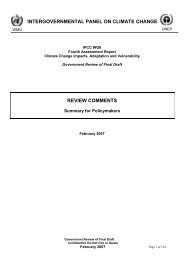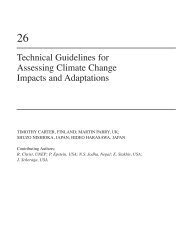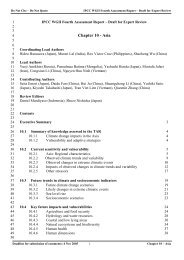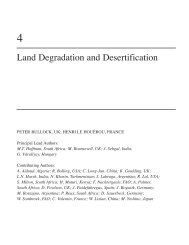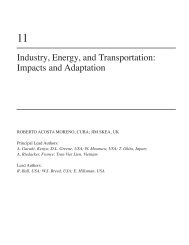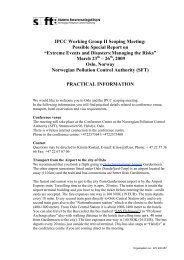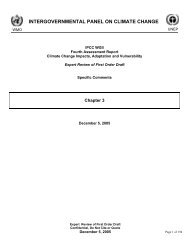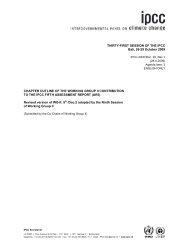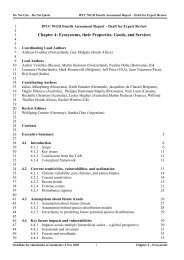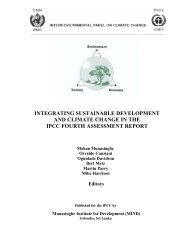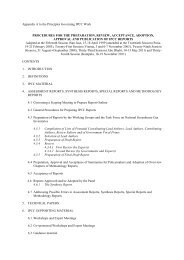IPCC Expert Meeting on Geoengineering
IPCC Expert Meeting on Geoengineering
IPCC Expert Meeting on Geoengineering
Create successful ePaper yourself
Turn your PDF publications into a flip-book with our unique Google optimized e-Paper software.
Annex 4: Poster Abstracts<br />
Cloud-resolving modeling of marine stratocumulus cloud brightening<br />
Hail<strong>on</strong>g Wang 1 , Philip J. Rasch 1 *, and Graham Feingold 2<br />
1<br />
Atmospheric Sciences and Global Change Divisi<strong>on</strong>, Pacific Northwest Nati<strong>on</strong>al Laboratory, USA<br />
2<br />
Chemical Sciences Divisi<strong>on</strong>, NOAA Earth System Research Laboratory, USA<br />
Marine Stratocumulus (Sc) clouds cover vast areas of the ocean surface. They play a prominent role affecting the Earth’s<br />
albedo and energy budget. The possibility of mitigating some c<strong>on</strong>sequences of global warming by brightening these clouds<br />
(Latham, 2002) has been explored in various global modeling studies, providing important insight into some aspects of this<br />
idea. However, the inability of global models to adequately represent cloud-scale physics and dynamics due to low model<br />
resoluti<strong>on</strong> limits their usefulness for assessing the climate system resp<strong>on</strong>se to cloud brightening. High-resoluti<strong>on</strong> cloud<br />
modeling has proven to be a useful tool for process-level understanding of aerosol-cloud-precipitati<strong>on</strong> interacti<strong>on</strong>s. It can<br />
also provide a necessary and critical test to the assumpti<strong>on</strong>s and parameterizati<strong>on</strong>s employed by global models when<br />
exploring the geoengineering idea.<br />
In this study (H. Wang et al., 2011), we use the high-resoluti<strong>on</strong> Weather Research and Forecasting (WRF) model with<br />
explicit treatment of aerosol-cloud-precipitati<strong>on</strong> interacti<strong>on</strong>s to perform cloud-system-resolving simulati<strong>on</strong>s of cloud<br />
brightening. The same model c<strong>on</strong>figurati<strong>on</strong> has been used by Wang and Feingold (2009a) to examine the transiti<strong>on</strong> from<br />
closed-cell Sc to open cells. The two distinct cellular structures that have starkly different reflectance patterns (also revealed<br />
by satellite imagery; e.g.,Garay et al., 2004; Wood and Hartmann, 2006), have been shown to be associated with aerosol<br />
effects <strong>on</strong> rain-producti<strong>on</strong> processes and dynamical feedbacks in a self-organizing system (Stevens et al., 2005; H. Wang<br />
and Feingold, 2009a; Feingold et al., 2010). More relevant to cloud brightening, however, is that <strong>on</strong>ce the open cells are<br />
established, they appear to be resilient to aerosol perturbati<strong>on</strong>s. Another key result is that gradients in aerosols and<br />
precipitati<strong>on</strong> can generate mesoscale circulati<strong>on</strong>s that impact clouds well bey<strong>on</strong>d the c<strong>on</strong>venti<strong>on</strong>al “aerosol indirect<br />
effects” (H. Wang and Feingold, 2009b).<br />
Based <strong>on</strong> these prior studies, we c<strong>on</strong>ducted experiments with four combinati<strong>on</strong>s of different meteorological and aerosol<br />
background c<strong>on</strong>diti<strong>on</strong>s observed in the Northeast Pacific Sc regime. Seawater particles are injected into the model<br />
atmosphere by single, multiple or numerous sprayers. In the first two cases, sprayers are allowed to move at a speed of 5 m<br />
s-1 in the domain approximately the size of a climate model grid box, while in the latter case sprayers are uniformly<br />
distributed over the model domain. The average surface injecti<strong>on</strong> rate of 1.45×106 m-2 s-1 is close to that suggested by<br />
Salter et al. (2008). The injecti<strong>on</strong> strategy is critical in influencing the spatial distributi<strong>on</strong> of the additi<strong>on</strong>al aerosols. Both<br />
areal coverage and local number c<strong>on</strong>centrati<strong>on</strong> are important players in cloud brightening but neither <strong>on</strong>e always emerges<br />
as dominant. For a given amount of aerosols, the two aspects need to be balanced to optimize the enhancement of cloud<br />
amount and albedo. In the cases where clouds are susceptible to aerosol perturbati<strong>on</strong>s, injecti<strong>on</strong> from single or multiple<br />
sprayers can introduce a significant heterogeneous resp<strong>on</strong>se in the domain. The study also suggests that mesoscale<br />
circulati<strong>on</strong>s induced by rain suppressi<strong>on</strong> associated with multi-sprayers can have unforeseen influence <strong>on</strong> cloud structures<br />
and brightness depending <strong>on</strong> the distance between the sprayers, and that diurnal variati<strong>on</strong>s of clouds and precipitati<strong>on</strong><br />
may be important for the effective timing of seeding.<br />
Results show that the effectiveness of cloud brightening depends str<strong>on</strong>gly <strong>on</strong> meteorological and background aerosol<br />
c<strong>on</strong>diti<strong>on</strong>s and, sometimes, the injecti<strong>on</strong> strategy. Suppressing rain as a means of sustaining cloud water is the most<br />
efficient way to brighten clouds in the cases c<strong>on</strong>sidered here. Hence, it is very effective in a weakly precipitating boundary<br />
layer in which the additi<strong>on</strong>al aerosols can substantially weaken the precipitati<strong>on</strong>. Seeding the aerosol-limited cloud in<br />
c<strong>on</strong>diti<strong>on</strong>s preceded by heavy and/or persistent rain that has significantly depleted existing aerosols is also effective. The<br />
same amount of injected material is less effective in either str<strong>on</strong>gly precipitating clouds or aerosol-rich clouds. Cloud drops<br />
grow large enough to rain out in the former case even in the presence of additi<strong>on</strong>al aerosols. Cloud brightening is<br />
ineffective in a relatively dry boundary layer that supports clouds of low liquid water path. In the aerosol-rich case and the<br />
dry case, the aerosol injecti<strong>on</strong> increases drop number c<strong>on</strong>centrati<strong>on</strong>s but lowers supersaturati<strong>on</strong> and liquid water path. As a<br />
result, the cloud experiences very weak albedo enhancement, regardless of the injecti<strong>on</strong> method. Detailed results have<br />
been published in Wang et al. (2011), part of which is to be presented at the meeting.<br />
<str<strong>on</strong>g>IPCC</str<strong>on</strong>g> <str<strong>on</strong>g>Expert</str<strong>on</strong>g> <str<strong>on</strong>g>Meeting</str<strong>on</strong>g> <strong>on</strong> <strong>Geoengineering</strong> - 57


